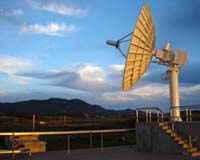 |
Houston TX (SPX) Feb 11, 2011 For the second time in less than a month, two Russian cosmonauts will venture outside the International Space Station on Feb. 16 to install a pair of earthquake and lightning sensing experiments, and to retrieve a pair of spacecraft material evaluation panels. Expedition 26 Flight Engineers Dmitry Kondratyev and Oleg Skripochka are scheduled to float outside the Pirs airlock at 8:15 a.m. EST Wednesday to begin the five-and-a-half-hour excursion. Both spacewalkers will wear Russian Orlan-MK spacesuits. On their previous spacewalk, completed Jan. 21, they completed installation of a new high-speed data transmission system, removed an old plasma pulse experiment, installed a camera for the new Rassvet docking module and retrieved a materials exposure package. That spacewalk lasted 5 hours, 23 minutes. Kondratyev again will be designated as Extravehicular 1 (EV1), with a red stripe on his suit, and Skripochka will be EV2, with a blue stripe on his suit. This time, both cosmonauts will wear NASA-provided helmet lights and wireless television cameras to provide live point-of-view video to Mission Control-Moscow, which will provide ground support for the spacewalk. Mission Control-Houston will monitor the spacewalk as well. The spacewalk will focus on installation of two scientific experiments outside the Zvezda service module. The first is called Radiometria, and is designed to collect information useful in seismic forecasts and earthquake predictions. Radiometria will be installed on a portable workstation on the port side of the large-diameter section of the Zvezda module. The second is Molniya-Gamma, which will look at gamma splashes and optical radiation during terrestrial lightning and thunderstorm conditions using three sensors. The Molniya-Gamma will be installed on a portable workstation on the starboard side of the Zvezda module. Kondratyev and Skripochka also will retrieve two Komplast panels from the exterior of the Zarya module. The panels contain materials exposed to space, and are part of a series of international experiments looking for the best materials to use in building long-duration spacecraft. Additionally, they will remove and jettison a space suit foot restraint, and deploy a small satellite named ARISSat-1. ARISSat-1, also known as Radioskaf-V, is the first of a series of educational satellites being developed in a partnership with the Radio Amateur Satellite Corp. (AMSAT), the NASA Office of Education ISS National Lab Project, the Amateur Radio on ISS (ARISS) working group and RSC-Energia. The small satellite is a project that follows in the footsteps of SuitSat, which was built within a retired Russian Orlan spacesuit that was not longer viable for use by humans and was deployed Feb. 3, 2006, by Expedition 12 Cosmonaut Valery Tokarev and Astronaut Bill McArthur. ARISSat satellites can carry up to five student experiments and the data from these experiments will be transmitted to the ground via an amateur radio link. In addition, ARISSat will transmit still-frame video Earth views from four onboard cameras, commemorative greetings in native languages from students around the world, and a Morse code tracking beacon. ARISSat also will function as a worldwide space communications utility for use by amateur radio operators. ARISSat-1 is expected to enter the Earth's atmosphere within three to six months after its deployment. As during the previous spacewalk, Commander Scott Kelly and Flight Engineer Alexander Kaleri will climb into their Soyuz 24 spacecraft, which is docked to the Poisk module on the opposite side of Zvezda from the airlock, and seal the hatches between Zvezda and Poisk. This protects against the unlikely possibility of a sudden station depressurization and also allows for the use of the forward portion of Zvezda as a backup airlock if necessary. Flight Engineers Cady Coleman and Paolo Nespoli will be in the U.S. segment and will have access to their Soyuz 25 spacecraft, which is docked to the Rassvet module adjacent to Pirs on the Zarya control module, therefore they do not need to be sequestered. With all tasks complete, Kondratyev and Skripochka will re-enter the Pirs airlock and end their spacewalk. The next Russian spacewalk is planned for July, when the Expedition 29 crew will be in orbit aboard the station.
Share This Article With Planet Earth
Related Links Shuttle at NASA Station at NASA Station and More at Roscosmos S.P. Korolev RSC Energia Watch NASA TV via Space.TV Space Station News at Space-Travel.Com
 Azorean Station To Track Ariane Launch
Azorean Station To Track Ariane LaunchParis, France (ESA) Feb 09, 2011 When ATV Johannes Kepler is lofted into space on 15 February, an ESA tracking station on Portugal's Santa Maria island will watch closely, gathering crucial data as Ariane 5 streaks overhead. In 2008, the Santa Maria station, located five kilometres from the town of Vila do Porto on the Portuguese island of Santa Maria, in the Azores, became the latest station to join ESA's global ESTRACK ... read more |
|
| The content herein, unless otherwise known to be public domain, are Copyright 1995-2010 - SpaceDaily. AFP and UPI Wire Stories are copyright Agence France-Presse and United Press International. ESA Portal Reports are copyright European Space Agency. All NASA sourced material is public domain. Additional copyrights may apply in whole or part to other bona fide parties. Advertising does not imply endorsement,agreement or approval of any opinions, statements or information provided by SpaceDaily on any Web page published or hosted by SpaceDaily. Privacy Statement |